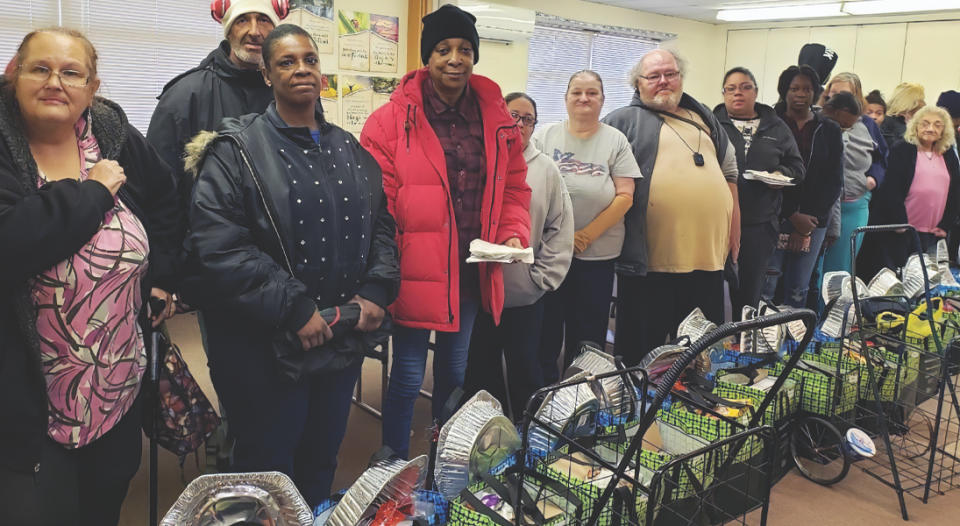For many Christians, meals begin not with picking up a fork but with a moment of silence to give thanks. For Jessica Cameron, who lives in a food desert, that pause of gratitude comes from a very grateful heart. “I think how great it is to be able to receive [this food],” she said.
Every Sunday, immediately after worship at St. Paul Lutheran Church in Millville, N.J., she and others “shop” along a line of tables in the parking lot or the education wing of the church, choosing from vegetables, meats, potatoes, eggs and whatever is being harvested that week in this farm-rich area of southern New Jersey.
A 54-year-old double amputee, Cameron especially values St. Paul’s feeding ministry because the church is just two blocks away from her apartment. Her only other option for fresh food is a chain supermarket two miles north, and her only way of getting there is to roll her wheelchair to a bus stop three blocks away.
“It’s convenient for me,” Cameron said of the St. Paul ministry. “It’s wonderful that people there care about people.”
Higher inflation has made grocery shopping more challenging in almost every nation, but for some 39 million Americans, even finding or reaching a supermarket can be a real, everyday challenge. More than 1 in 10 Americans live in a “food desert,” typically low-income, inner-city neighborhoods where supermarket chains are hesitant to operate, transportation is limited, and breakfast, lunch and dinner options might be little more than a packaged product from a gas station or convenience store.
“They have the prices raised so high in these convenience stores around here that people can’t afford it,” Cameron said.
Downtown Millville, where Cameron lives, is only one of many identified food deserts in New Jersey, where the cost of living already ranks sixth highest in the nation. Advocates say that in Trenton, 75 miles to the north of Millville and much more populous, they once spotted a gallon of milk priced at $9.25 in a recognized chain grocery store with few competitors.
Food and advocacy
Sara Lilja, an ELCA pastor who serves as director of the New Jersey Synod’s Lutheran Episcopal Advocacy Ministry of New Jersey (LEAMNJ), sees firsthand the challenge everyday Americans face in putting food on the table
Forty percent of New Jersey residents, she said, are “housing distressed,” meaning they spend more than 30% of their income on rent or house payments. That imbalance often leads to problems affording enough food for everyone in the home.
In New Jersey and elsewhere, congregations such as St. Paul often are at work to fill in the gaps. Fully 95% of ELCA congregations provide their communities with free meals, food distribution or some sort of food assistance. Food banks dot the landscape in every state, helping those congregations and other groups feed those in need.
And every five years in the halls of Congress, senators and representatives hammer out legislation largely unknown to the everyday shopper: the farm bill.
Known or not, the farm bill has been a fixture of the nation’s agricultural economy since the 1930s, when President Franklin Roosevelt signed the first versions to shore up falling farm prices and stabilize the U.S. food supply during the Great Depression and Dust Bowl.
Since then, the farm bill has been renewed every five years, setting policy on everything from price supports to funding levels for school lunch programs. Congress passed the latest farm bill in 2018 and will vote on its renewal in 2023, probably by the fall.
“People know to call upon us. We’re small, but we’re mighty.”
No matter what details emerge in the 2023 Farm Bill, faith-based organizations will continue to feed the hungry. But as Lilja explained, the details and funding levels will have a “huge impact” on the availability and accessibility of food for millions of Americans.
At LEAMNJ, Lilja’s staff and volunteers already are preparing video testimonies for legislators, asking residents in food deserts and elsewhere to “tell their stories” of hunger and share successful hunger solutions.
The folks at St. Paul, which averages 60 worshipers on a Sunday morning, are such witnesses. When Karen Bernhardt became pastor of St. Paul in 2016, she found parishioners somewhat wary of their neighbors, but they quickly embraced her call to assist the “working poor” in downtown Millville.
“I was very fortunate that our congregation has an open heart for this,” Bernhardt said. “People know to call upon us. We’re small, but we’re mighty.”
Though the fine points of the farm bill may change every five years, Lilja said the St. Paul program enjoys “pretty robust” support across party lines.
Food banks, local governments and agencies such as Lilja’s highlight the changing nature and demographics of hunger in America. For instance, advocates are seeing an unprecedented rise in hunger on college campuses, to the point where some faculty stock food closets for the students they see falling asleep from lack of nutrition.
Lilja finds that faith communities in New Jersey and beyond “have incredible on-the-ground feeding systems set up.” But they can’t meet the need alone, she said.
“We don’t have nearly the capacity to purchase the foods,” Lilja said. “We can’t do it alone, and the federal government can’t do it without us. We have to partner together.”
To learn more about the ELCA’s advocacy efforts or to become involved, visit elca.org/advocacy or search for “farm bill” at elca.org.





